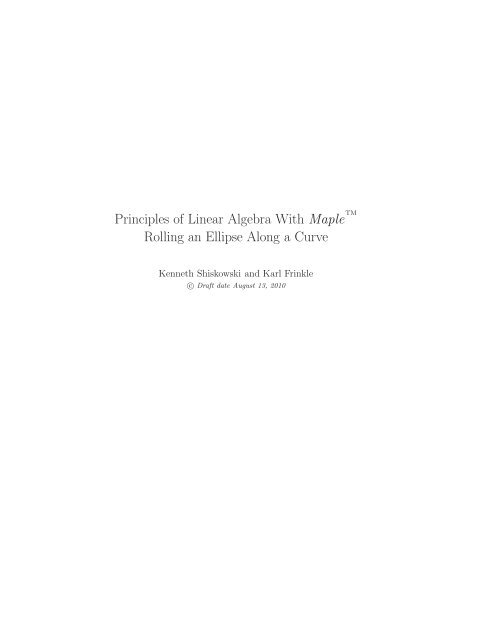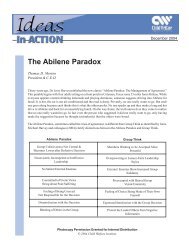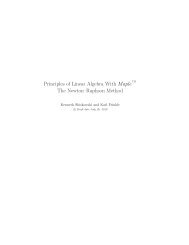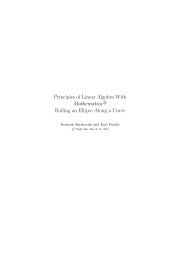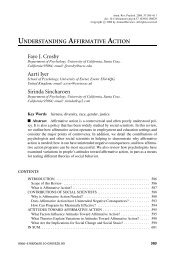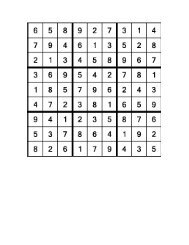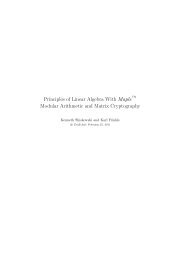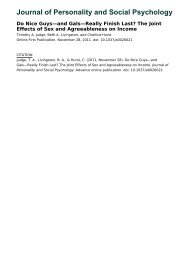Principles of Linear Algebra With Maple Rolling an Ellipse Along a ...
Principles of Linear Algebra With Maple Rolling an Ellipse Along a ...
Principles of Linear Algebra With Maple Rolling an Ellipse Along a ...
You also want an ePaper? Increase the reach of your titles
YUMPU automatically turns print PDFs into web optimized ePapers that Google loves.
Contents1 <strong>Rolling</strong> <strong>an</strong> <strong>Ellipse</strong> <strong>Along</strong> a Curve 11.1 The Setup . . . . . . . . . . . . . . . . . . . . . . . . . . . . . . 11.2 The First . . . . . . . . . . . . . . . . . . . . . . . . . . . . . . 31.3 Automating the Process . . . . . . . . . . . . . . . . . . . . . . 91.4 Further Questions to Consider . . . . . . . . . . . . . . . . . . 13v
Chapter 1<strong>Rolling</strong> <strong>an</strong> <strong>Ellipse</strong> <strong>Along</strong> aCurve1.1 The SetupIn Section 7.2 <strong>of</strong> <strong>Principles</strong> <strong>of</strong> <strong>Linear</strong> <strong>Algebra</strong> <strong>With</strong> <strong>Maple</strong> TM , we discussed thetopic <strong>of</strong> “rolling” a circle along a curve. Of course, the rolling was in quotesdue to the fact that we were really just sliding the circle along the curve. The<strong>an</strong>imation have the appear<strong>an</strong>ce <strong>of</strong> a rolling circle, but this was due only tothe fact a circle is a perfectly symmetric object, <strong>an</strong>d no matter which way it isrotated, there is no apparent ch<strong>an</strong>ge in orientation. So what happens if we pick<strong>an</strong> object which is not as symmetric? Take, for inst<strong>an</strong>ce, <strong>an</strong> ellipse. Clearly if<strong>an</strong> ellipse is rotated through most <strong>an</strong>gles, it will be obvious to <strong>an</strong> observer thatthe ellipse was indeed rotated. The only two <strong>an</strong>gles for which this is not thecase is θ = π <strong>an</strong>d θ = 2π. The question then becomes: what additionally mustbe done to rotate <strong>an</strong> ellipse versus a circle?To determine some <strong>of</strong> the math required to rotate <strong>an</strong> ellipse, we will startwith a simple setup, that <strong>of</strong> rolling the ellipse along a horizontal line, similarto rolling a football, along a level surface, end over end. We define <strong>an</strong> ellipsewith center at (x c ,y c ) parametrically asx(t) = x c +acos(t)y(t) = y c +bsin(t)(1.1)wherea<strong>an</strong>dbarethe length<strong>of</strong>the major/minoraxescorresponding,dependentupon a > b or a < b. If we graph this ellipse, starting at t = 0, then initiallywee have the point (x c +a,y c ). The bottom most point on the ellipse occurswhen t = 3 2 π, yielding the point (x c,y c −b). So in order to roll <strong>an</strong> ellipse along1
4 Chapter 1. <strong>Rolling</strong> <strong>an</strong> <strong>Ellipse</strong> <strong>Along</strong> a Curve>plot(2-evalf(int(sqrt(16*sin(t)ˆ2+4*cos(t)ˆ2),t=3*Pi/2..t1)),t1=0..2*Pi);15L10502 4 6t1Figure 1.2: Difference <strong>of</strong> 2 <strong>an</strong>d the arclength <strong>of</strong> the ellipse> <strong>Ellipse</strong>F(5.229238282);[3.976573758,2.261239222]> plot4:= pointplot([<strong>Ellipse</strong>F(3*Pi/2), <strong>Ellipse</strong>F(5.229238282)], symbol = diamond,symbolsize = 20, color = GREEN):> plot5:= pointplot([4,2], symbol=circle, symbolsize=20, color=black):> display({plot1, plot2, plot3, plot4, plot5},view=[-3..10,-3..10]);108y642–2 0 2 4x6 8 10–2Figure 1.3: Original point on the ellipse which touches the line, <strong>an</strong>d the newpoint which will touch the line after rolling two units to the right.
1.2 The First Step 5> display({plot1, plot2, plot3, plot4, plot5}, view=[1..5, 1..3], scaling = constrained);32.5y21.512 3 4 5xFigure 1.4: Close-up <strong>of</strong> Figure 1.3 near the desired point <strong>of</strong> rotationNow we need to rotate the ellipse. But we are missing one import<strong>an</strong>t piece<strong>of</strong> information, the <strong>an</strong>gle <strong>of</strong> rotation. We need to construct the pair <strong>of</strong> vectorswhich will yield the correct <strong>an</strong>gle <strong>of</strong> rotation. As a first guess, you may try touse the three points depicted in Figure 1.4 above, but perform the resultingcalculations show that this will not work. The next obvious idea is to still usethe horizontal line for one vector, but as second vector, use the t<strong>an</strong>gent lineat the new point on the ellipse which will be touching the horizontal line afterrotation. This also makes use determine where this t<strong>an</strong>gent line intercepts thehorizontal line y = 2. We illustrate this in the <strong>Maple</strong> code <strong>an</strong>d Figure 1.5following.> <strong>Ellipse</strong>F(t);[2+4cos(t),4+2sin(t)]> M:= diff(<strong>Ellipse</strong>F(t),t)[2]/diff(<strong>Ellipse</strong>F(t),t)[1];> m:= evalf(subs(t=5.229238282, M));M := − 1 cos(t)2 sin(t)m := 0.2841928836> solve(subs({y=2},y-<strong>Ellipse</strong>F(5.229238282)[2]=m*(x-<strong>Ellipse</strong>F(5.229238282)[1])), x);3.057341655> arrow1:= arrow([3.057341655, 2], [3.976573758, 2.261239222], .02, .1, .1,color = black):> arrow2:= arrow([3.057341655, 2], [4, 2], .02, .1, .1, color = black):
1.2 The First Step 7it back so that its center is back at the original center. To do this, we takethe ellipse function F(t), <strong>an</strong>d subtract the center (2,4) from the correspondingcomponents. Next, we rotate using the rotation matrix[ ]cos(θ) −sin(θ)A θ =(1.4)sin(θ) cos(θ)<strong>an</strong>d our formula for the rotated ellipse, F θ (t) is now given byF θ (t) = A θ (F(t)−(2,4))+(2,4). (1.5)> <strong>Ellipse</strong>Col:=matrix(2,1,<strong>Ellipse</strong>F(t)-[2,4]);[ ]4cos(t)<strong>Ellipse</strong>Col :=2sin(t)> Atheta:= theta->matrix(2,2,[cos(theta),-sin(theta),sin(theta),cos(theta)]):> New<strong>Ellipse</strong>:= evalm(Atheta(-theta r)&*<strong>Ellipse</strong>Col);[ ]3.847638271cos(t)+0.5467357072sin(t)New<strong>Ellipse</strong> :=−1.093471414cos(t)+1.923819136sin(t)> plot7:=plot([New<strong>Ellipse</strong>[1,1]+2,New<strong>Ellipse</strong>[2,1]+4,t=0..2*Pi],color=blue,thickness = 2):> display({plot1,plot2,plot3,plot4,plot5,plot6,plot7}, view = [-4..10, -4..10]);108y642–4 –2 0 2 4x6 8 10–2–4Figure 1.6: Original ellipse <strong>an</strong>d the rotated ellipse, both at center (2,4)We have successfully rotated the ellipse, now we need to move it into thecorrect position. This must be a simple shift <strong>of</strong> some kind, but we need to findthe right one, keeping in mind that we wish to automate this process. Theone thing we must be sure <strong>of</strong>, is that the lowest point on the rotated ellipse
8 Chapter 1. <strong>Rolling</strong> <strong>an</strong> <strong>Ellipse</strong> <strong>Along</strong> a Curve(corresponding to t = 5.229238282) must move to the point (4,2) since that ishow far to the right we are rolling the ellipse along the horizontal line. Correspondingly,theoriginalcenter(2,4)mustthereforebeshiftedthesameamount!> LowestPoint:= [evalf(subs({t=5.229238282}, New<strong>Ellipse</strong>[1,1])), evalf( subs({t=5.229238282}, New<strong>Ellipse</strong>[2,1]))];LowestPoint := [1.425963908,−2.212862355]> plot8:= pointplot(LowestPoint, color = black, symbol = circle, symbolsize= 20):> minimize(New<strong>Ellipse</strong>[2,1],t=5..5.6);> ShifT:= Bottom-LowestPoint;−2.212862355ShifT := [2.574036092,4.212862355]> NewNew<strong>Ellipse</strong>:= evalm(New<strong>Ellipse</strong>+ShifT);[ ]3.847638271cos(t)+.5467357072sin(t)+2.574036092NewNew<strong>Ellipse</strong>:=−1.093471414cos(t)+1.923819136sin(t)+4.212862355> plot9:= plot([NewNew<strong>Ellipse</strong>[1,1], NewNew<strong>Ellipse</strong>[2,1], t=0..2*Pi], color =blue, thickness=2, scaling=constrained):> plot10:= pointplot(ShifT, color = black, symbol = cross, symbolsize = 10):> display({plot1,plot2,plot3,plot4,plot5,plot9,plot10}, view = [-3..10, -3..10]);108y642–2 0 2 4x6 8 10–2Figure1.7: Originalellipse<strong>an</strong>dtherotatedellipse, bothinthecorrectpositions.
1.3 Automating the Process 91.3 Automating the ProcessNow that we know how <strong>an</strong> ellipse c<strong>an</strong> be rolled to to right a single fixed dist<strong>an</strong>ceto the right, we need to determine how to create a process for repeatingthe process. We will start the process from the previous section over, this timemaking things more flexible so that the process c<strong>an</strong> be repeated in a for loop.> restart:> with(linalg): with(plots): with(<strong>Linear</strong><strong>Algebra</strong>):The variables xc <strong>an</strong>d yc will correspond to the center <strong>of</strong> the ellipse, <strong>an</strong>d a<strong>an</strong>d b are the lengths along the x-axis <strong>an</strong>d y-axis <strong>of</strong> the ellipse, respectively.> xc:=2; yc:=4;> a:=2; b:=4;xc := 2yc := 4a := 4b := 2The definition <strong>of</strong> the ellipse, as a function <strong>of</strong> t, where 0 ≤ t ≤ 2π is givennext.> <strong>Ellipse</strong>F:=[xc+a*cos(t),yc+b*sin(t)];<strong>Ellipse</strong>F := [2+4cos(t),4+2sin(t)]The variable r corresponds to how far to the right we wish to go for each step.The variable yline is the y =line that the ellipse will roll along.> r:= 0.5:> yline:= yc-b;yline := 2Next we calculate the total perimeter <strong>of</strong> the ellipse. This will help is later,when we need to use the fsolve comm<strong>an</strong>d to locate the times that sweep outarclengths <strong>of</strong> length r given above, which is where we come up with the formulain the definition <strong>of</strong> the variable S.> totalPerimeter:= evalf(int(sqrt(diff(a*cos(t),t)ˆ2 + diff(b*sin(t),t)ˆ2), t =0..2*Pi));totalPerimeter := 19.37689643
10 Chapter 1. <strong>Rolling</strong> <strong>an</strong> <strong>Ellipse</strong> <strong>Along</strong> a CurveThe variable numsteps tells us how m<strong>an</strong>y steps to the right we will go,Atheta is the st<strong>an</strong>dard rotation matrix, t0 is the initial time corresponding tothe point on the ellipse that touches the line yline. The variable xval is wherewe start the ellipse rolling, in the x-direction.> numrsteps:= 40:> S:= (totalPerimeter/r)/numrsteps;S := 0.9688448215> Atheta:= theta->matrix(2,2,[cos(theta),-sin(theta),sin(theta),cos(theta)]):> t0:= 3*Pi/2:> xval:= xc:Wewillw<strong>an</strong>ttoploteachellipse, <strong>an</strong>dcorrespondingcenter,aswegothroughthe for loop. Therefore we initialize a couple <strong>of</strong> plots.> Plot<strong>Ellipse</strong>[1]:= plot([<strong>Ellipse</strong>F[1], <strong>Ellipse</strong>F[2], t = 0..2*Pi], color = blue,thickness = 3):PlotCenter[1]:= pointplot([xc, yc], symbol = cross, symbolsize = 15, color= red):We now do the for loop which, which automates each step from the previoussection. See if you c<strong>an</strong> determine exactly how the following code works,<strong>an</strong>d relate it back to the steps used in Section 1.2.> for k from 1 to numrsteps dots:= fsolve(r = evalf(int(sqrt(diff(<strong>Ellipse</strong>F[1],t)ˆ2 + diff(<strong>Ellipse</strong>F[2],t)ˆ2),t=t0..t1)), t1,t0..t0+3*S):M:= diff(<strong>Ellipse</strong>F[2], t)/diff(<strong>Ellipse</strong>F[1], t):m:= evalf(subs(t=ts, M));xint:= solve(subs({y=yline}, y-subs({t=ts},<strong>Ellipse</strong>F[2])=m*(x- subs(t=ts,<strong>Ellipse</strong>F[1]))), x):Cpt:= [xint,yline]:Tpt:= [evalf(subs(t=ts,<strong>Ellipse</strong>F[1])), evalf(subs(t=ts,<strong>Ellipse</strong>F[2]))]:Bpt:= [xval+k*r, yline]:u:= :v:= :theta r:= evalf(VectorAngle(u,v)):<strong>Ellipse</strong>Col:= evalf(<strong>Ellipse</strong>F-[xc,yc]):New<strong>Ellipse</strong>:= evalm(Atheta(-theta r)&*<strong>Ellipse</strong>Col):Lpt:= [evalf(subs(t=ts,New<strong>Ellipse</strong>[1])), evalf(subs(t=ts, New<strong>Ellipse</strong>[2]))]:ShifT:= evalf([Bpt[1]-Lpt[1], Bpt[2]-Lpt[2]]):TempFunc:= [evalm(New<strong>Ellipse</strong>+ShifT)[1], evalm(New<strong>Ellipse</strong>+ShifT)[2]]:<strong>Ellipse</strong>F:= TempFunc:
1.3 Automating the Process 11xc:= ShifT[1]:yc:= ShifT[2]:Plot<strong>Ellipse</strong>[k+1]:= plot([<strong>Ellipse</strong>F[1],<strong>Ellipse</strong>F[2],t=0..2*Pi], color = blue,thickness = 3):PlotCenter[k+1]:= pointplot([xc,yc], symbol = cross, symbolsize = 15,color = red):print([evalf(t0), evalf(ts), evalf(m), xint, theta r]);t0:=ts:end do:[4.712388981,4.837634224,0.06295213005,2.250818442,0.06286916815][4.837634224,4.964377945,0.06524991473,2.752337634,0.06515755071][4.964377945,5.094260323,0.07024557186,3.253993975,0.07013037181][5.094260323,5.229238281,0.07889852891,3.755899408,0.07873541969][5.229238281,5.371839344,0.09315749557,4.258205308,0.09288940404][5.371839344,5.525564365,0.1169956373,4.761116197,0.1164661717][5.525564365,5.695516530,0.1589181977,5.264841596,0.1576002841][5.695516530,5.889027416,0.2374022491,5.769127160,0.2330872702][5.889027416,6.113472938,0.3806155108,6.270699972,0.3636847478][6.113472938,6.360840027,0.5264205469,6.759057056,0.4845599565][6.360840027,6.596574059,0.4473881505,7.238960154,0.4206797897][6.596574059,6.801150074,0.2827341251,7.732725761,0.2755422530][6.801150074,6.979000636,0.1827302672,8.234910919,0.1807362574][6.979000636,7.138131068,0.1299721980,8.738278564,0.1292476649][7.138131068,7.284443626,0.1006979579,9.241201103,0.1003596554][7.284443626,7.421956334,0.08346104147,9.743577472,0.08326805914][7.421956334,7.553505394,0.07300086043,10.24554568,0.07287159184][7.553505394,7.681226798,0.06677931948,10.74724501,0.06668031490][7.681226798,7.806856500,0.06353635545,11.24878696,0.06345106277][7.806856500,7.931928746,0.06269043691,11.75026255,0.06260850623][7.931928746,8.057926053,0.06409838242,12.25175412,0.06401081046][8.057926053,8.186417244,0.06800045527,12.75334713,0.06789592349][8.186417244,8.319215528,0.07511350205,13.25514343,0.07497271764][8.319215528,8.458595981,0.08693581881,13.75727742,0.08671779473][8.458595981,8.607632126,0.1064909067,14.25993315,0.1060910764][8.607632126,8.770734819,0.1401247346,14.76333529,0.1392182749][8.770734819,8.954371422,0.2017240386,15.26752838,0.1990527406]
12 Chapter 1. <strong>Rolling</strong> <strong>an</strong> <strong>Ellipse</strong> <strong>Along</strong> a Curve[8.954371422,9.166689926,0.3181753113,15.77094742,0.3080468784][9.166689926,9.408443977,0.4868817082,16.26561855,0.4530980124][9.408443977,9.652710266,0.5042403084,16.74558633,0.4670341024][9.652710266,9.869234493,0.3388261544,17.23342977,0.3266859207][9.869234493,10.05615447,0.2131173091,17.73374068,0.2099759606][10.05615447,10.22152186,0.1461548899,18.23703360,0.1451273440][10.22152186,10.37210920,0.1098907450,18.74016874,0.1094515809][10.37210920,10.51255477,0.08896094943,19.24273800,0.08872737794][10.51255477,10.64607099,0.07634623448,19.74484234,0.07619841721][10.64607099,10.77501472,0.06872534658,20.24662846,0.06861744890][10.77501472,10.90124534,0.06445684485,20.74821819,0.06436780345][10.90124534,11.02635382,0.06274518131,21.24970894,0.06266303789][11.02635382,11.15182601,0.06329655010,21.75118488,0.06321222467]> Yplot:=plot(yline,x=-3..30,color=BLACK, thickness=2):> for j from 1 to numrsteps+1 doPlotTog[j]:=display([Plot<strong>Ellipse</strong>[j],PlotCenter[j], Yplot]):end do:> display([seq(PlotTog[l],l=1..numrsteps+1)], insequence = true, scaling =constrained, axes = none);Figure 1.8: Nine frames in the <strong>an</strong>imation <strong>of</strong> rolling the ellipseFigure 1.8 is the culmination <strong>of</strong> all <strong>of</strong> our work thus far. Unfortunately, wec<strong>an</strong>not display the actual <strong>an</strong>imation here, so nine frames are show at the sametime. The lighter ellipse on the left is the first in the series. Also note thateach subsequent ellipses rests on the horizontal line, even after being rotated.So it appears that we have successfully rolled <strong>an</strong> ellipse along a horizontal line!
1.4 Further Questions to Consider 13> display(seq(PlotCenter[j], j = 1..numrsteps+1), view = [0..25, 0..10], scaling= constrained);108y64205 10 15 20 25xFigure 1.9: The centers <strong>of</strong> each <strong>of</strong> the ellipses throughout the rotationShowing all 41 ellipses at the same time would not help us view the processat all. However, in Figure 1.9, the center <strong>of</strong> each ellipse is displayed. Notethat the dist<strong>an</strong>ce between centers is signific<strong>an</strong>tly less when the curvature <strong>of</strong>the portion <strong>of</strong> the ellipse resting on the line is larger. This corresponds to theportions <strong>of</strong> the ellipse closest to the minor axes.1.4 Further Questions to ConsiderWe end with a discussion (<strong>an</strong>d leave you with questions) on how to generalizethis process. Before we do this, we must realize what restrictions were used inall the work done previous. The most import<strong>an</strong>t assumption that was made,wasthatourcurvethat werolledthe ellipsealongwasactuallyahorizontalline.1. How do things ch<strong>an</strong>ge if we decide not to use a horizontal line, but a linewith nonzero slope instead?If you c<strong>an</strong> determine the <strong>an</strong>swer to this question, then the following shouldbe <strong>an</strong>swerable as well. Remember, that if we were rolling <strong>an</strong> ellipse a dist<strong>an</strong>cer to the right along a horizontal line, where the ellipse touched the line atthe point (x p ,y p ), we then knew that the rotated ellipse would be touchingthe horizontal line at the point (x p +r,y p ). This is clearly not the case for aline with nonzero slope! Furthermore, we also use the fact that the line washorizontal to help compute the <strong>an</strong>gle <strong>of</strong> rotation needed. This must ch<strong>an</strong>ge aswell! If you c<strong>an</strong> figure out how to adapt the previous work to allow for lines onnonzero slope, then the following questions may also be <strong>an</strong>swerable.
14 Chapter 1. <strong>Rolling</strong> <strong>an</strong> <strong>Ellipse</strong> <strong>Along</strong> a Curve2. What must be modified to roll <strong>an</strong> ellipse along a curve given in the formy = f(x)?3. What happens if you wish to roll <strong>an</strong> ellipse along a parametric curve <strong>of</strong>the form (x,y) = (x(s),y(s))? Is this really a generalization <strong>of</strong> question 1 or ismore mathematics required?


